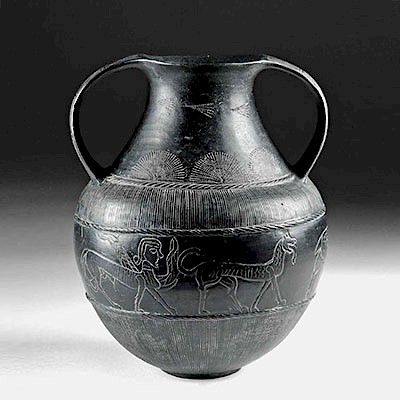Colima Redware Seated Hunchback Dwarf - ex-Sotheby's
Lot 183
About Seller
Artemis Gallery
686 S Taylor Ave, Ste 106
Louisville, CO 80027
United States
Selling antiquities, ancient and ethnographic art online since 1993, Artemis Gallery specializes in Classical Antiquities (Egyptian, Greek, Roman, Near Eastern), Asian, Pre-Columbian, African / Tribal / Oceanographic art. Our extensive inventory includes pottery, stone, metal, wood, glass and textil...Read more
Estimate:
$5,000 - $7,500
Absentee vs Live bid
Two ways to bid:
- Leave a max absentee bid and the platform will bid on your behalf up to your maximum bid during the live auction.
- Bid live during the auction and your bids will be submitted real-time to the auctioneer.
Bid Increments
| Price | Bid Increment |
|---|---|
| $0 | $25 |
| $300 | $50 |
| $1,000 | $100 |
| $2,000 | $250 |
| $5,000 | $500 |
| $10,000 | $1,000 |
| $20,000 | $2,500 |
| $50,000 | $5,000 |
| $100,000 | $10,000 |
| $200,000 | $20,000 |
About Auction
By Artemis Gallery
Mar 21, 2019
Set Reminder
2019-03-21 10:00:00
2019-03-21 10:00:00
America/New_York
Bidsquare
Bidsquare : Fine Ancient | Asian | Ethnographic Art
https://www.bidsquare.com/auctions/artemis-gallery/fine-ancient-asian-ethnographic-art-3967
Featuring classical antiquities, ancient and ethnographic art from cultures encompassing the globe, plus fine art. Egyptian, Greek, Roman, Etruscan, Near Eastern, Asian, Pre-Columbian, Native American, African / Tribal, Oceanic, Spanish Colonial, Russian, Fine Art, so much more! Artemis Gallery info@artemisgallery.com
Featuring classical antiquities, ancient and ethnographic art from cultures encompassing the globe, plus fine art. Egyptian, Greek, Roman, Etruscan, Near Eastern, Asian, Pre-Columbian, Native American, African / Tribal, Oceanic, Spanish Colonial, Russian, Fine Art, so much more! Artemis Gallery info@artemisgallery.com
- Lot Description
Pre-Columbian, West Mexico, Colima, Protoclassic Period, ca. 100 BCE to 250 CE. Simple yet elegant in style and boasting sublime technique, a beautiful redware vessel depicting a male dwarf seated upon a flat base with curved, attenuated legs. The highly-burnished figure suffers from a severe case of dwarfism made evident by his dramatic forward-leaning posture and his malformed spine which almost protrudes through his back. Short, bent arms extend downwards from rounded shoulders, and a squat neck supports a bulbous head. Incised coffee-bean-shaped eyes, a triangular nose, slightly-parted puffy lips, and tab-shaped ears comprise the dwarf's visage, and a bulbous brow gradually tapers to a flared spout rim. In Pre-Columbian times, the deformities of hunchbacked people were believed to be signs from the divine that they were in fact special, chosen individuals who were touched by the supernatural. Size: 7.4" W x 11.4" H (18.8 cm x 29 cm).
Hunchback and dwarf individuals are very common in Colima sculpture - indeed, they heavily outnumber portrayals of women (and some have theorized that this relates to their relatively high social status in the society). Some scholars attribute the hunched back in West Mexican shaft tomb culture to a particular form of tuberculosis; the protruding shoulders of this example may be part of the figure's deformity or the result of an emaciated state.
Colima, located on Mexico's southwestern coast, was during this time part of the shaft tomb culture, along with neighbors to the north in Jalisco and Nayarit. In this culture, the dead were buried down shafts - 3 to 20 meters deep - that were dug vertically or near vertically through the volcanic tuff that makes up the geology of the region. The base of the shaft would open into one or more horizontal chambers with a low ceiling. These shafts were almost always dug beneath a dwelling, probably a family home, and seem to have been used as family mausoleums, housing the remains of many related individuals. This is a figure made to be placed inside those mausoleums, perhaps to mediate between the worlds of the living and the dead.
For a similar example of a Colima seated hunchback figure, please see The Metropolitan Museum of Art, accession number X.2.431: https://www.metmuseum.org/art/collection/search/318295
Provenance: private Florida, USA collection; ex-Sotheby's, New York Pre-Columbian Art Auction (sale 6500, November 22, 1993, lot 97)
All items legal to buy/sell under U.S. Statute covering cultural patrimony Code 2600, CHAPTER 14, and are guaranteed to be as described or your money back.
A Certificate of Authenticity will accompany all winning bids.
We ship worldwide and handle all shipping in-house for your convenience.
#137890Vessel professionally repaired from multiple large pieces with some resurfacing, overpainting, and restoration along break lines. Surface wear and abrasions commensurate with age, minor nicks to hands, feet, back, and head, with fading to some areas of pigmentation. Nice earthen deposits and manganese blooms across most surfaces.Condition
- Shipping Info
-
All shipping is handled in-house for your convenience. Your invoice from Artemis Gallery will include shipping calculation instructions. If in doubt, please inquire BEFORE bidding for estimated shipping costs for individual items.
-
- Buyer's Premium



 EUR
EUR CAD
CAD AUD
AUD GBP
GBP MXN
MXN HKD
HKD CNY
CNY MYR
MYR SEK
SEK SGD
SGD CHF
CHF THB
THB
















